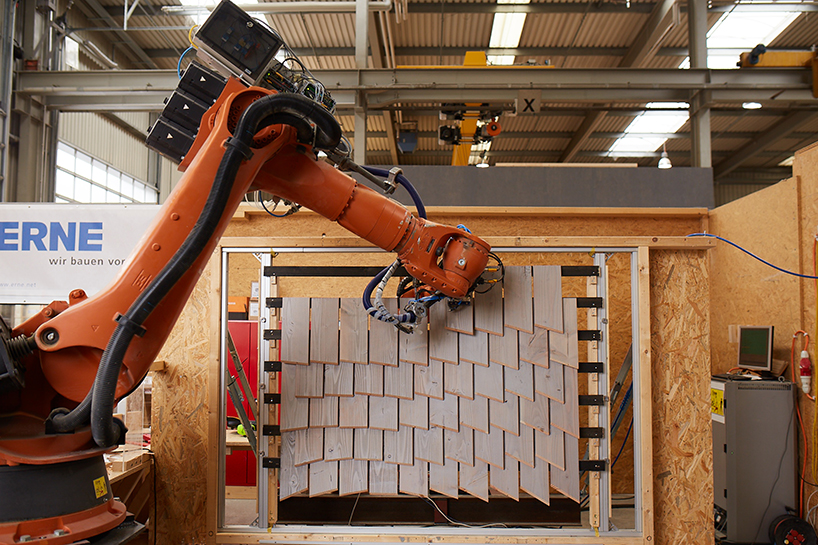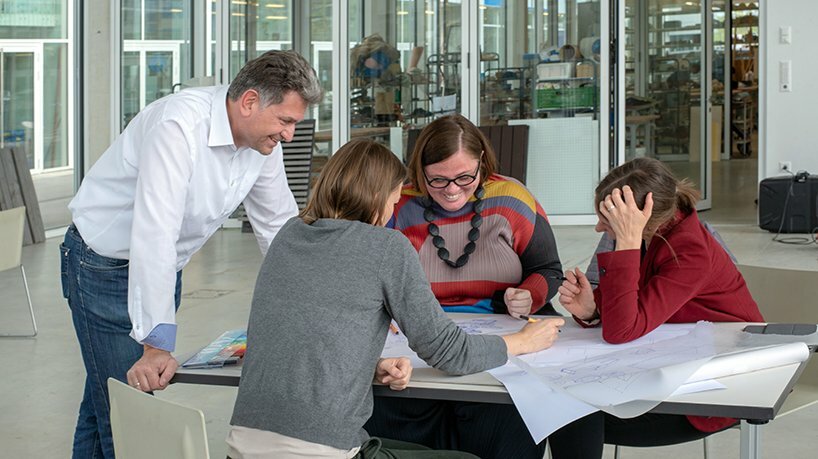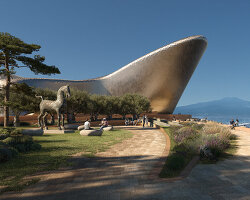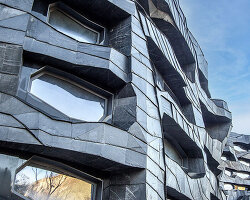collaborative design of prefabricated façade systems
CoDe façades is an innovative process for designing and fabricating unique, cost-efficient, and well-crafted custom wooden facades. the project started as research work between the FHNW academy of art and design and ERNE AG holzbau in response to the growing need for flexibility and adaptability in the construction industry while keeping the high quality of the final product. this system comprises three innovations applied in the industrial setup, resulting in an efficient and flexible design-to-production workflow.
the demonstrator of the project is a modular office building in stein, switzerland developed by four outstanding facades. carpenters, wood engineers, robotic specialists, and architects joined forces to develop a structure inspired by rich swiss woodcraft tradition, all the while incorporating new design and production technologies. therefore, the final composition is a modern reinterpretation of the historic wood façades (shingles, board-on-board, and beam-based facades) precisely crafted with the help of robots.

final project demonstrator- saig office in stein
images by zosia prominska
a combination of traditional craft knowledge with novel manufacturing technology
CoDe facades (see more here) was developed within an applied research ‘CoDeFa’ (collaborative design of prefabricated façade systems), between FHNW academy of arts and design (here) and ERNE AG holzbau (here), co-financed by innosuisse (here). the collaborative design approach is a method in which the architect, engineer, and manufacturer exchange on the early stage of the project during the design workshops. moreover, digital design and fabrication tools enable architects to generate a large scope of façade variations within the production feasibility of the manufacturer and engineers to prepare files for robotic production.
novel multi-robot fabrication processes allow for complex façade assembly. digital craftsmanship code facades introduced the concept of craftsmanship enhanced through digital means as a new value in the industrial realm. it can be observed on multiple levels. firstly, the design space offered to architects was derived from rich swiss woodcrafts tradition. the three most typical façade families: beam-based, shingles, and board-on-board, have been digitally reinterpreted and aesthetically expanded while keeping their original logic and performance. secondly, the system uses mixed fabrication, which intelligently combines automated and manual production. while the robotic processes improve precision, efficiency, and speed of construction, the material quality and surface finishes are ensured by the manual skills of the erne’s carpenters.
this increases the quality of the facades and lowers and cost of production. such an industrial setup, often associated with affordable and standardized solutions, is enriched with new values of crafts and individuality. lastly, the proposed process brings architects closer to making. by using integrative digital tools and through close collaboration with an industrial partner, architects can take a more active role in the construction sector and design with more awareness of manufacturing.

close up of the board-on-board facade
facades of office saig
the architectural potential of the system has been validated through the full-scale application on four facades of a single-storey temporary office building in stein, switzerland, with a total area of 220 sqm, constructed in november 2020. inspired by local traditional solutions, saig’s intricate facades stand out in a local industrial context. the system’s innovation lies in the introduction of design-driven flexible automation strategies into the industrial setup. these include an early exchange between architect and manufacturer, flexible digital design tool, and reconfigurable fabrication setup. where manual techniques would be impossible to implement or require custom-made formworks and complicated individual treatment of each element, the computational and fabrication methods offer flexibility, efficiency and high quality. this quality distinguishes the developed system from individualized expensive façade solutions currently available on the market.

window finishes within beam facade for saig office

two robots assembly at the ERNE AG holzbau fabrication facility

robotic assembly of shingle facade

saig building corner with two facade systems: shingles and beams

close up of beam-based facade with uneven cuts and depths

close up of shingle façade depicting a dynamic pattern of bottom cuts




project info:
name: CoDe facades (collaborative design of prefabricated façade systems)
designers: edyta augustynowicz, maria smigielska, daniel nikles
institute integrative design | masterstudio, HGK, FHNW: edyta augustynowicz (project lead), maria smigielska, daniel nikles (architectural design/ parametric process development/robotic process development), ralf michel, heinz wagner (academic advisory)
ERNE AG holzbau: thomas wehrle (project manager),
oliver ackermann, heiri treier, thomas reiner (wood engineering/ wood manufacturing and construction/ facade assembly)
project support: innosuisse – swiss innovation agency
designboom has received this project from our ‘DIY submissions‘ feature, where we welcome our readers to submit their own work for publication. see more project submissions from our readers here.
edited by: christina petridou | designboom

















